The Best Hard Boiled Eggs
A properly boiled egg is a great food, and useful for everything from a quick and healthy snack to a deluxe potato salad. But getting a perfect boiled egg is surprisingly difficult. There are a million instructions for them online and in cookbooks, and the results can vary wildly. If you’re making deviled eggs, or boiling eggs for any other reason, you want consistent, repeatable results.
Never fear, we have your back. We’ve done a lot of work on this and have brought you our favorite method for cooking perfect boiled eggs, every single time.
Boiled Egg Challenges
Improperly boiled eggs can be rubbery and chalky, with gross green rings surrounding the yolks.
We want to avoid those pitfalls with our eggs, and we’ve found that there is one method that works so consistently well that it’s all we use anymore.
Steaming is Our Top Recommended Hard Boiled Egg Cooking Method
For the best all-around hard boiled egg cooking method, we agree with experts who suggest steaming as the way to go. The shells slip right off and the eggs are silky smooth and unblemished. When cooked the appropriate amount of time, the texture of both the yolk and white is firm but still tender.
Steaming eggs
This method is the favorite of such experts as Jeff Potter, Cook’s Illustrated, Alton Brown, and Kenji Lopez-Alt, just to name a few.
- Prepare steamer or pot with a steam basket insert with 1 to 2 inches of water in the bottom of the pot. Put a lid on the pot and bring the water to a rolling boil before adding the eggs. The eggs should be suspended above the water.
- Place whole raw eggs in a single layer into a steamer, cover with a tight-fitting lid, and cook for 12 minutes.
- Shock in an ice bath for 15 minutes.
Result: This was our favorite method. The whites were tender and the yolk was smooth—almost fluffy as compared to the other yolks. Our favorite part about these boiled eggs was that each one was incredibly easy to peel.
Thermal Tip: Ice Bath & Starting Temp
Ice Bath: To immediately stop the cooking process, immediately dump your eggs into an ice bath after cooking and chill them for 10–15 minutes. The ice bath is an important step to halt carryover cooking to avoiding overcooking the eggs.
It also helps the boiled eggs to retain their round shape rather than flattening on the wide end. As the temperature of the egg protein increases it expands and flattens the air cell at the wide end of the egg. If the cooked egg cools slowly the air cell reinflates, creating a small dent in the bottom of the egg before it sets completely.
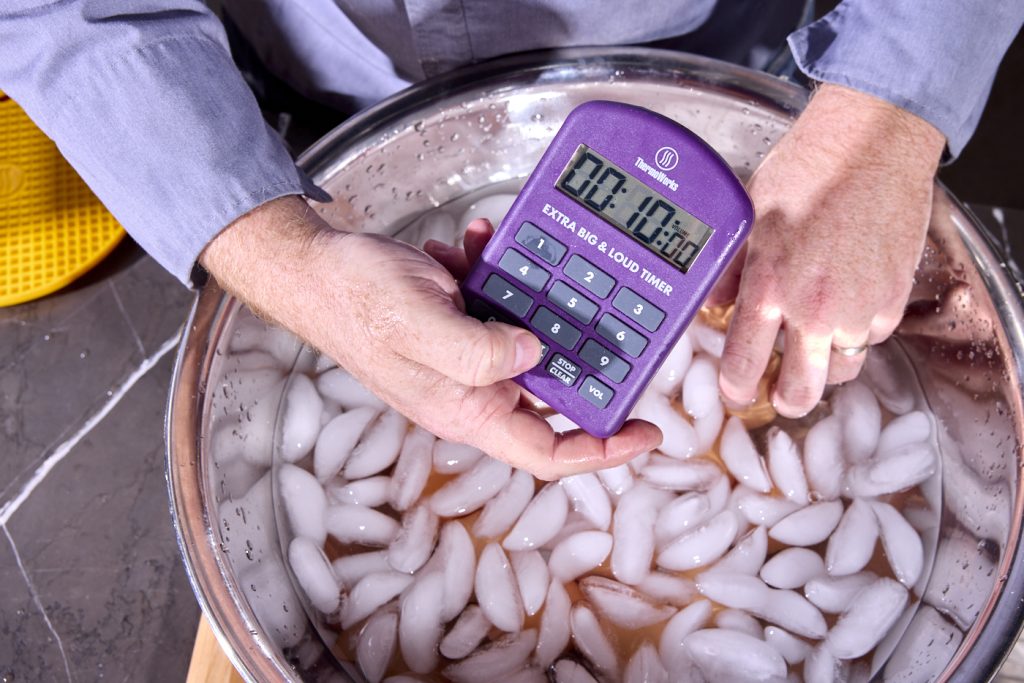
The Secret to Easy-to-Peel Hard Boiled Eggs is…Shocking!

Some say that boiling your eggs with salt or baking soda is the secret to easy-peeling eggs. But easy-to-peel hard-boiled eggs are all about temperature. The egg protein right beneath the shell needs to quickly set up, separating from the shell’s membrane—a cooking method that involves an initial shock of high heat is the way to go.
When the outermost layer of egg protein’s temperature rises gradually, it will fuse to the membrane right beneath the shell, making peeling difficult and as a result, the cooked egg’s surface will be pitted. If easy peeling is your goal, starting your eggs in cold water is the worst thing you can do.
Freshness also matters, but not how you think
But even given the shock, there’s one more thing to note that people don’t like to hear. It is this: fresher eggs are harder to peel well. The membrane of a super-fresh egg clings harder to the shell than does the membrane or an egg that has been around for a week. Or two. Use farm-fresh eggs for scrambles, omelets, and, especially, poching. But use the those eggs that have been in the fridge for a little while for boiling. Compound that with the ice bath shock, and you’ll have eggs that are easier to peel than ever.
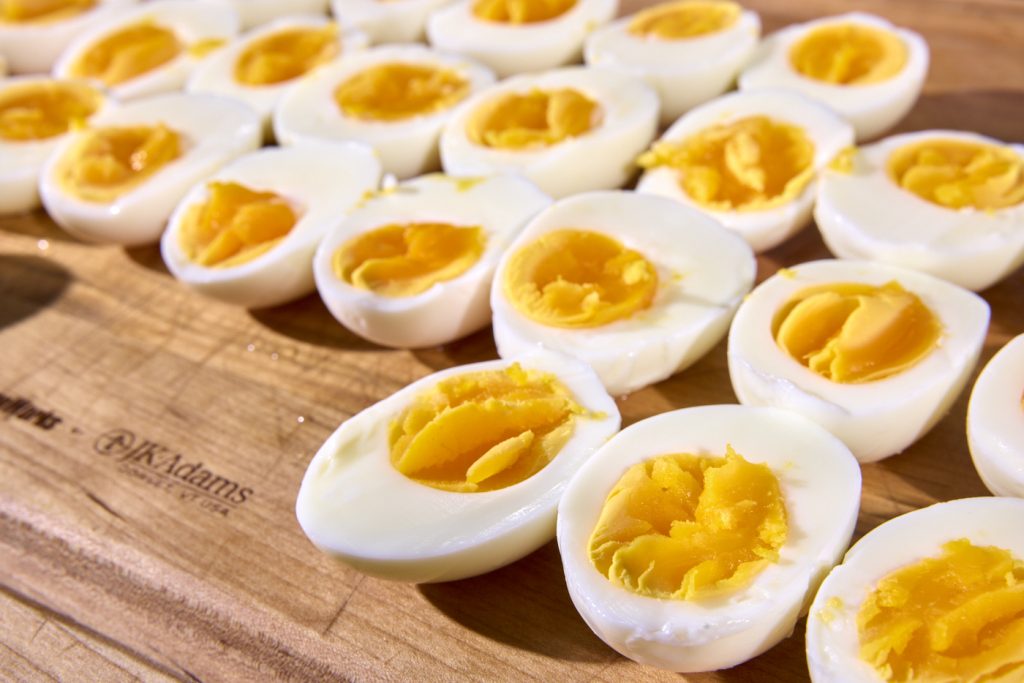
Understanding what’s going on with the food you cook really makes the experience easier, more enjoyable, and the results more delicious! Whether you’re making deviled eggs for a party or coloring Easter eggs with your family, keep these tips in mind and you’ll have the best hard boiled eggs yet.
Products Used:
Resources:
Cook’s Science, Cook’s Illustrated


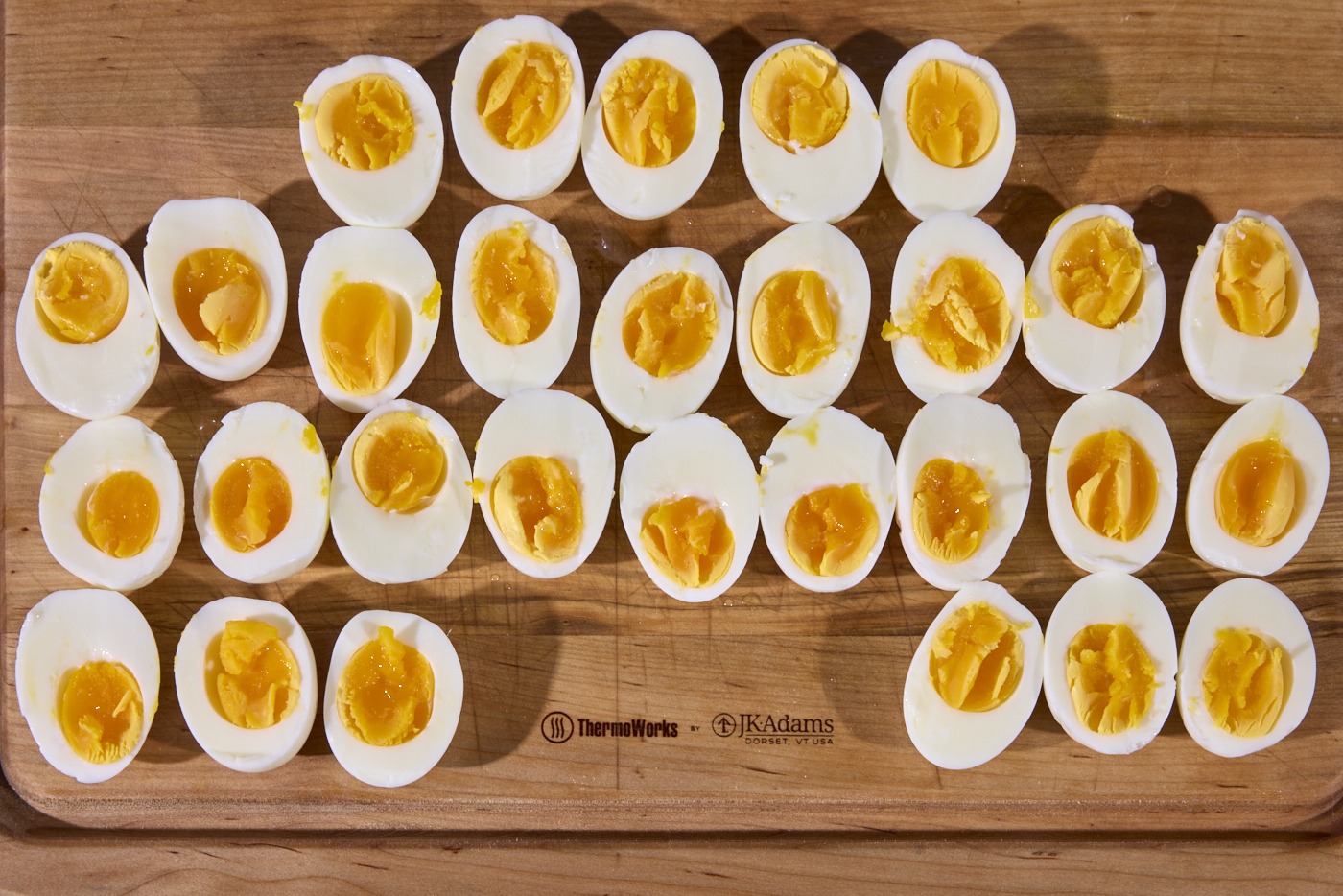
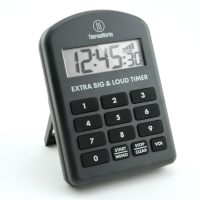
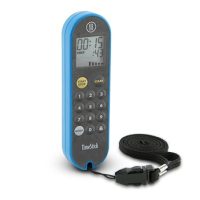
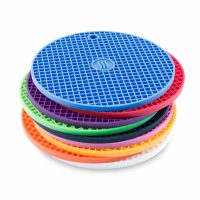
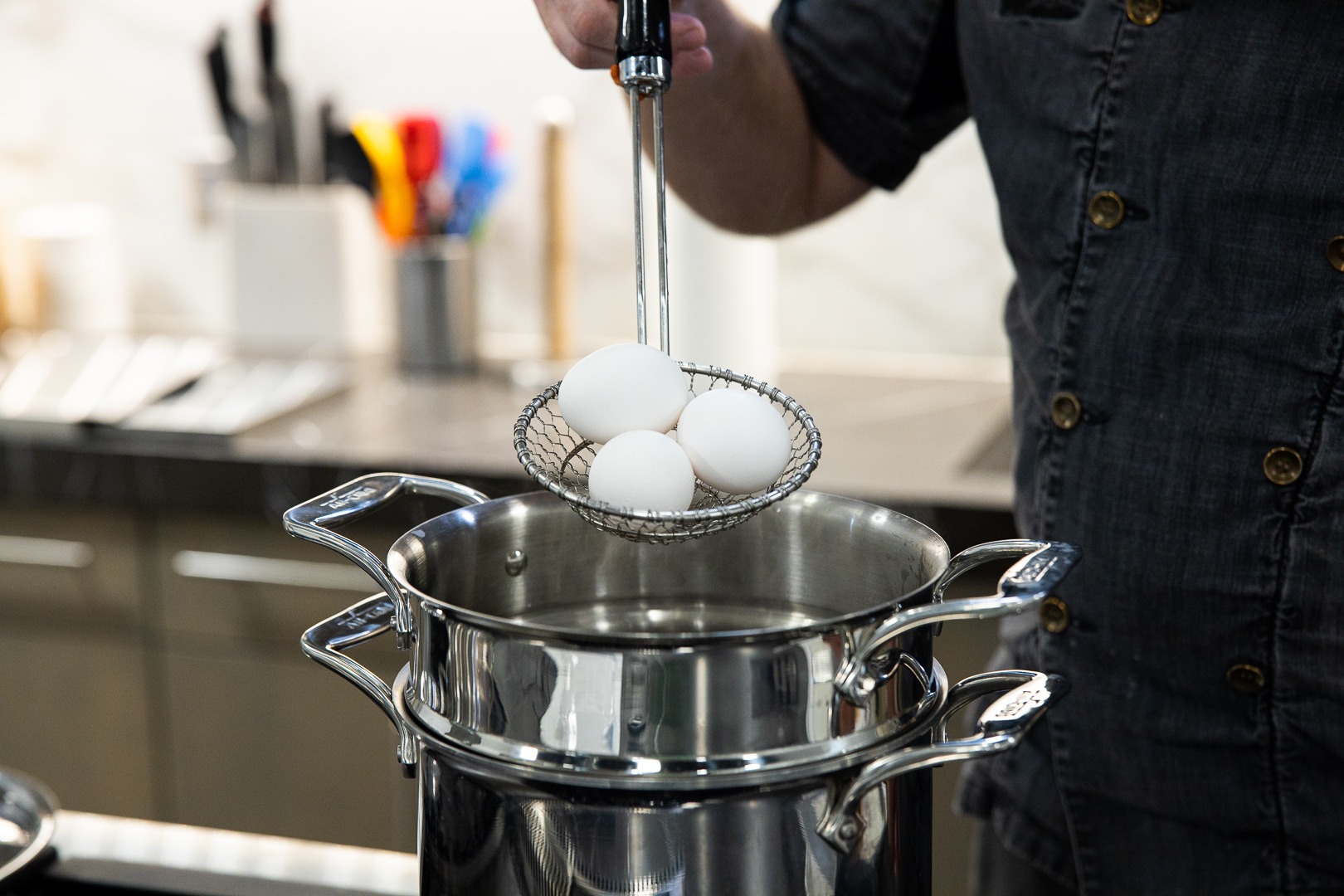
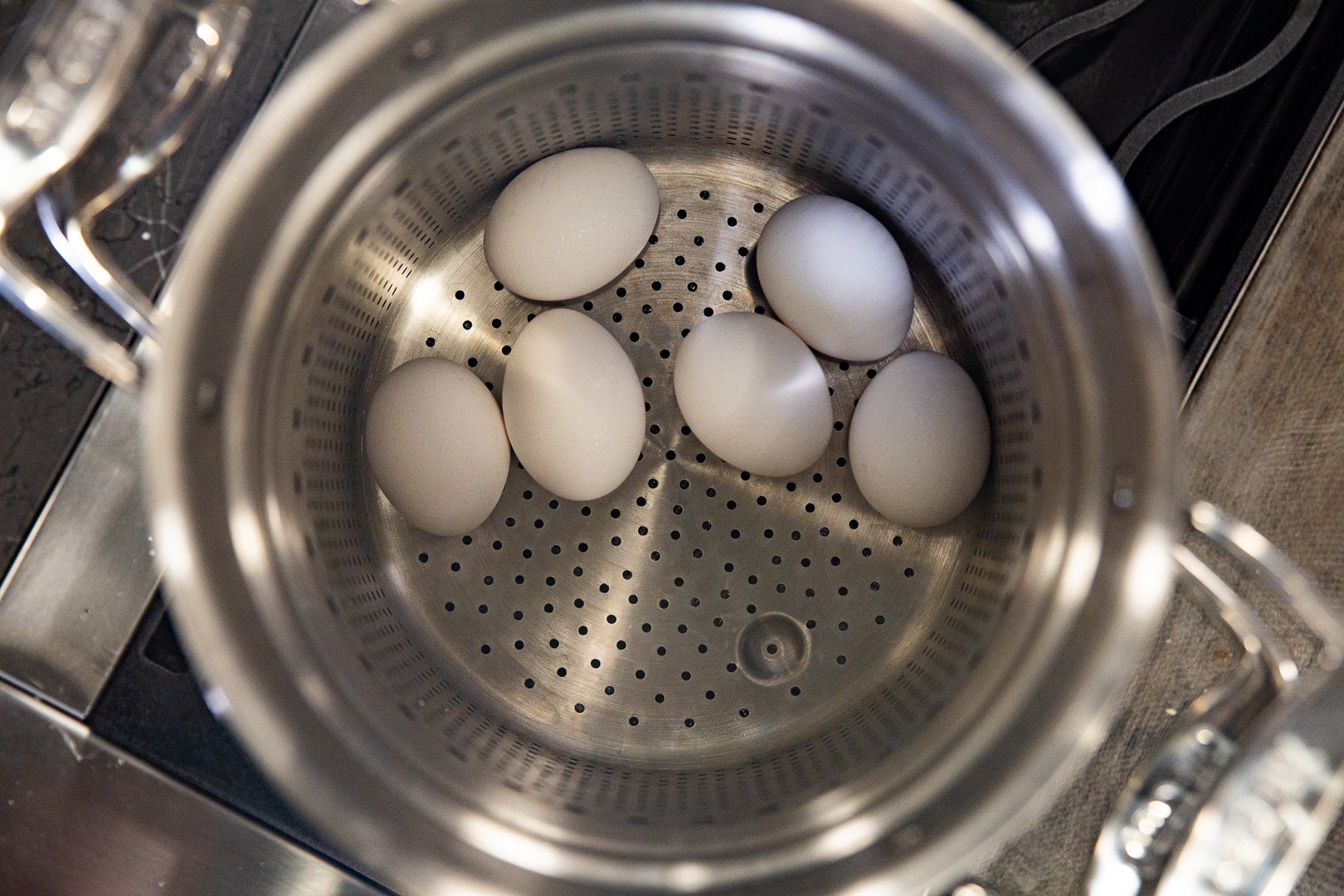
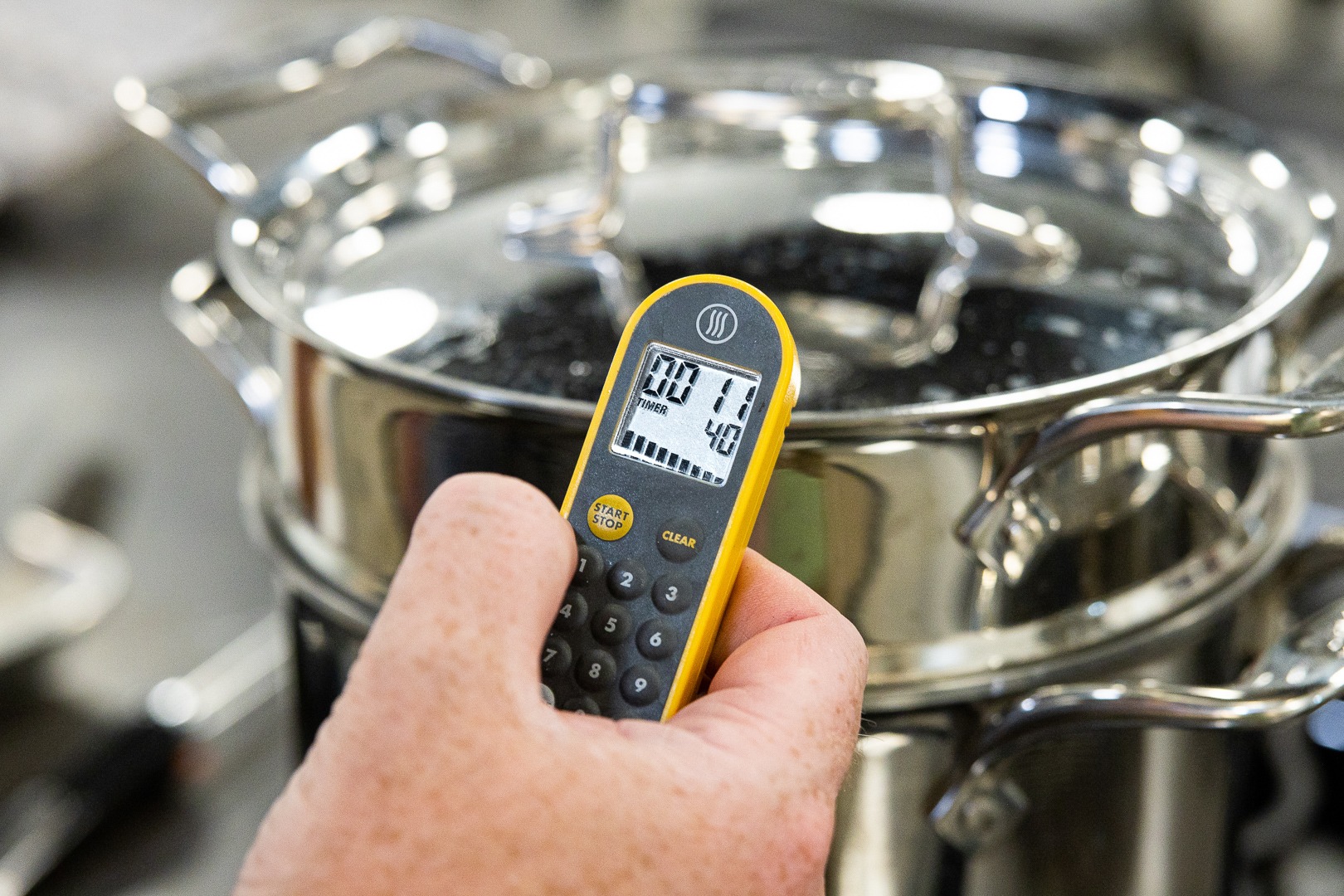
A wonderful comprehensive analysis of this overlooked skill.
Now we just have to get the word out to everyone!
Thank you.
Paul,
Thank you for your comment. And I agree! Everyone needs to know that steaming and shocking is the way to go!
Thanks again,
-Kim
in your recommended method of Steaming a few more details please. Is the water brought to a full boil before the steamer & eggs are added ? or started cold ? Cover the steamer pot immediately after eggs are added? can you overcrowd the steaming basket ?
Thank you in advance.
CA
Carl,
The water in the steamer is brought to a full boil before adding the eggs so they begin cooking immediately in a high-heat environment. The eggs are cooked directly from the refrigerator, cover the pot with a tight-fitting lid while cooking, and keep the eggs in a single layer in your steamer for even cooking.
Thanks!
-Kim
The questions I always have after reading articles about how to cook eggs, which no one seems to address, are; what is the impact of egg size on the cooking time, and are these cooking times based on eggs at room temperature or direct from the refrigerator? I always use extra large or jumbo eggs and store them in the fridge.
Stan,
The eggs are cooked cold directly from the refrigerator, and we used large eggs. Try cooking your extra large eggs for 1 additional minute, and your jumbo eggs for 2 additional minutes.
Thanks!
-Kim
This is very helpful; I will steam my Easter eggs this year. How does the temperature of the eggs before steaming affect cooking time – should they be cold, or at room temp, when they are placed into the steamer?
D,
Cook your eggs directly from the refrigerator.
Thanks!
-Kim
At what temperature should the eggs be when you put them into a steamer? Straight from the fridge or room temperature?
Zenon,
Cook your eggs straight from the refrigerator.
Thanks!
-Kim
Are your egg-cooking directions for any size egg? Should the eggs come right from the refrigerator when starting to cook?
John,
We used large eggs. If you’re using medium eggs, cook them for 1 minute less time, and about 1 additional minute for extra large eggs. The eggs were cooked cold directly from the refrigerator.
Thanks!
-Kim
I’ll try the steaming method to compare but currently use a method not mentioned. Put eggs in cold water, bring just to boil. Once water reaches a boil, cover and take off the heat. Let sit for 12 minutes for large eggs, 15 minutes for extra large. Come out tender and yolk is not dry at all. Sometimes easy to peel, sometimes less so. I’ve read that that’s due to age of eggs. Super fresh eggs are harder to peel.
J,
Thank you so much for your comment! It’s amazing how many different methods there are for cooking eggs.
-Kim
I should have tried the steaming method before posting my comment. I’m a convert!
J,
Isn’t it amazing?! And so simple too. I’m so glad you gave the steaming method a try.
Thanks,
-Kim
When steaming, are the basket and lid in place while the water is brought to a boil, then the eggs are added and allowed to steam for 12 minutes? And does the lid go back on during that 12 minute steaming process? That info was a little scant on details. :-/ Thanks!
David,
Very good questions. The water in the steamer is brought to a boil first so the cold eggs are placed immediately into a high heat environment. Cover the pot with a tight-fitting lid and cook for 12 minutes.
Thanks!
-Kim
Excellent analysis. What about pricking the air sack end to prevent cracking and misshapen eggs? Is that needed, or does it help when steaming them? It certainly does when dropping eggs into boiling water.
Bruce,
There are definitely some who suggest pricking the air cell at the wide end of the egg. It definitely can help. However, the process of shocking the eggs in an ice bath sets the still-soft egg protein in its shell for a perfectly round egg. Give it a try!
Thanks!
-Kim
Unfortunately, the blog completely disregards the effect of altitude on timing. As altitude increases, the boiling point of water decreases, and the time to cook anything in water (or steam) increases.
This omission is surprising, since Thermoworks is located in a high mountain valley. This reader has no idea whether the timing in the blog is meant for 4500 feet, or whether sea level timing is meant.
Paul,
You are correct. At our altitude, the boiling point is about 203-204°F and the lower air pressure seems to affect baking and sugar cooking the most where we are. The expert methods we sourced were written for sea level conditions and worked at our altitude.
With lower boiling points at very high altitudes, you’ll need to increase the steaming or boiling time to thoroughly cook your eggs. The egg needs to reach a temperature of about 170-180°F to set up firmly from edge to edge. At an elevation of 10,000 feet, the boiling point is about 193-194°F—still high enough for the eggs to reach their doneness temperature.
The exact amount of time will vary depending on your specific altitude, but the increase will likely be around 2 minutes at 5,000-6,000 ft, and 6-8 minutes at 10,000 feet.
Thank you for your comment,
-Kim
In these experiments, were the eggs room temperature or refrigerator temperature?
Richard,
The eggs were cold, cooked directly from the refrigerator.
Thanks!
-Kim
When steaming the eggs in your test, were the eggs at refrigerator temperature (~35F) when placed in the steamer or were they first brought to room temp? I suspect this would impact cooking time for the desired result. Any recommendations as to steaming time for both scenarios?
Joe,
We used cold eggs directly from the refrigerator for all of the cooking methods, and that is also the recommendation of such experts as Kenji Lopez-Alt, Alton Brown, and Cook’s Illustrated. It does impact the final result. You have greater chances of overcooking your eggs when starting with room temperature eggs. Try reducing the cooking time by two minutes if you do start with warmer eggs.
Thanks!
-Kim
I’ve been using the technique recommended by the Michigan Egg Producers Assoc. for years with always perfect results.. Cover eggs with an inch of cold water. Bring to a rolling boil. Remove from heat. Let stand for 15 minutes. Remove from water. Let stand to room temperature. Refrigerate for use as needed.
When steaming eggs do you start with an already steaming pot or start with a cold steamer?
Mary,
Start by preparing your steamer first. The water should be boiling before adding the eggs.
Thanks,
-Kim
Great article. I will have to try the steam method next time.
I am wondering how egg size affects this. The article did not mention if these were large eggs etc. So would extra large require an extra minute? Small eggs less time?
Mark,
Very good question. We used large eggs. For medium eggs experiment with removing them at 11 minutes, and 13 minutes for extra large eggs.
Thanks!
-Kim
Just a couple questions regarding the steaming method of hard boiled eggs.
Should the water be boiling under the seamer basket when the eggs are put on.
When the 12 minutes are up do you shock them in cold water like other methods?
I may be giving this one a try. My biggest problem has always having problems peeling the eggs. Even tried not using Extra fresh eggs.
Lynne,
Prepare your steamer by bringing the water to a boil before adding the eggs. The water level should be below the level of your steamer basket so the eggs are not touching the water. And yes, shock the steamed eggs in an ice bath immediately after the 12 minutes are up.
Let us know how it goes!
Thanks,
-Kim
I had read about the “Ice water bath” method to stop the cooking before, and once I understood this and started to use it, my eggs were no longer overlooked.
That said, I am anxious to try the steamed method you described above because I am still dealing with the annoying “peeling” problem.
The one question I have is, “Should the eggs be at room temperature before I start the cooking process, or can they go directly from the fridge into the steamer”?
Thanks for the great article!
Michael,
Cook your eggs directly from the refrigerator.
Thanks!
-Kim
What is the “best” temperature for haddock?
Roman,
The internal doneness temperature for seafood as recommended by the USDA for food safety is 145°F. Many chefs recommend a doneness temperature of 130-135°F for fish like haddock.
Thanks!
-Kim
In ‘The Perfect Hard Boiled Egg’ there is one small, but I suspect very significant detail left out of the process …. are the eggs started at room temperature or refrigerated?
Tim,
Yes, that important detail wasn’t originally included but has been added to the post. Cook your eggs directly from the refrigerator.
Thanks!
-Kim
Thank you, Kim.
Tim
So, a few comments…
1. I was taught, and my experience matches, that the green around the egg yolk comes from overcooking the egg. If you overcook a fresh egg, you can get the green layer.
2. Older eggs do peel more easily; fresher egg whites beat more easily for meringues/ angel food cakes.
Most commercial eggs are 2+-weeks old. If you store your eggs covered, even commercial eggs will be good for more than a month. Actually even longer. I had a buyer for a military commissary in Asia explain how they kept a 2-month supply of eggs in a giant walk-in refrigerator so that they couldn’t be forced into paying the local providers more. He told me that they could go for up to 3 months — and still keep a reasonable shelf life for consumers.
If you’re using eggs from a local farm (or your own) you might want to let them age for a week or so before you make hard cooked eggs so that they’ll peel easier. (But they make amazing angel food cakes.) The fresher eggs also make wonderful poached eggs, w/almost none of the white becoming runny. (I’m talking about real poached eggs floated in a pan of water and not coddled eggs made in a cup or dish.
3. I like having hard cooked eggs around and years ago acquired the Chefs Choice egg cooker. It works w/the steaming method. You can shift the timing if you want soft cooked eggs or if you’re using different sized eggs. It’s one of the few special use items I own. It holds 7 eggs and I can easily use it while cooking in the kitchen. When the alarm goes off, I can easily lift out the rack and lower it into a bowl of ice water.
Does the boiled egg timing vary with altitude using the steamed process? We live in Billings, Montana where the altitude is about 3500 feet. Please respond.
Larry,
Excellent question. Our altitude here in Utah is 4,500 feet and the 12 minutes worked very well for our steamed eggs. You could experiment by pull 1 egg at 11 minutes, one at 12, and another at 13 to see what the yolk texture difference will be.
Thanks!
-Kim
Interesting, informative and timely! Do you start all methods with eggs at room temp or cold from fridge?
Toni,
We obviously overlooked that part of the post! All of the eggs were cooked directly from the fridge. Thanks for your question!
-Kim
The time and results would seem to depend on the temperature of the eggs before any cooking method is started. For the times and results given in your article, what was the initial temperature of the eggs? If it was provided, I missed it. Thanks.
Bruce,
The eggs were cooked directly from the refrigerator.
Thanks!
-Kim
Thank you for the thorough analysis of this age-old problem. I was wondering, however, what the starting temperature of the eggs was for your experiments. Should the eggs be at room temperature or right out of the fridge? I assume this would affect cooking times.
Neil,
Yes. The eggs were cooked directly from the refrigerator.
Thanks!
-Kim
My elevation is 5750′. My water boils about 201-202 degrees. Would my steaming time still be 12 minutes or do I need slightly longer? I definitely do not want soft yolks. Thanks.
Aurora,
Our elevation is about 4500 feet and our boiling point is about 203-204°F. 12 minutes worked perfectly well for our eggs. If you want to experiment, pull one egg at 12 minutes and another at 13 to see if there is a noticeable difference.
Good question, thanks!
-Kim
You don’t indicate the starting temperature for the eggs, e.g., the ones steamed. Is it room temperature (20C)? Refrigerator temperature (2C)?
Dan,
The eggs are cooked directly from the refrigerator.
Thanks!
-Kim
I inspected eggs for USDA as part of my duties with a state department of agriculture where I worked for 33 years. I was also the secretary of a state poultry association for 16 years. I was taught by those in the industry to hard boil eggs by starting them in cold water, boiling gently for 5 minutes, pulling them off the heat and letting them stand for 10 minutes and then cooling them rapidly in cold water. The whites are firm and I thought the yolk texture was fine. However, I am intrigued by the steaming method described above. I do have a question. Do you insert the steamer basket of eggs into an already steaming pot or do you insert the basket when the pot is cold, bring it up to steaming and then time for 11 minutes?
I have always found fresh eggs difficult to peel using the boiling method and want to see if steaming fresh eggs makes a difference.
Alton,
The steaming method really does make a huge difference in the peelability of the boiled eggs. Give it a try!
The water in your steam setup needs to be fully heated before adding the eggs. Then start your 12 minute timer.
Thanks!
-Kim
The only thing you left off is, adding after a boil is reached, baking soda. This step makes the peel easier. 1/2 to 1 tsp will work well in a small amount of eggs, 4 to 6.
Try it and let me know how you fare.
OOPS! That is what you said.. So sorry, yes I carefully place my eggs in boiling water. After adding the soda, the temp drops. It will rise again as you know.
Loudmouth misspeaks again.
I have a couple of questions–do you use eggs straight from the refrigerator, or room-temperature eggs? Do you put the steamer basket containing the eggs over the water before it reaches the boiling point, or wait until the water boils and then add the basket with eggs? Thanks.
Patricia,
Great questions. The eggs are placed in the steamer basket directly from the fridge, and the eggs are placed into the steamer after the water has reached the boiling point.
Thanks!
-Kim
Hi There
For the steam method of hard cooked eggs, do you place in ice water after cooking?
Scott,
Yes, the steamed eggs are placed in an ice bath for 15 minutes immediately after cooking.
Thanks!
Kim
Excellent article and very easily understood and answered many questions re eggs.
Mel,
So glad to hear it! It’s such a simple food to cook, but it’s nice to understand things a little better for the best results possible.
Thanks,
-Kim
After steaming, do you cold shock the eggs in ice water? Or just let them cool down other wise?
Dale
Dale,
Yes. The eggs in each cooking method, including steaming, were shocked in an ice bath immediately after cooking.
Thanks!
-Kim
My technique is to first puncture the large end with a tine from a corn ear holder then drop into cold water in 2 qt pan of water. Bring to a boil over high heat. As soon as it is at full boil take the pan off the heat and let sit for 10 to 15 minutes depending on the number of eggs. After sitting time has expired I run cold water in the pan and roll the eggs against the side of the pan until they are cracked all around. Once the eggs are cooled, I peel them under water.
I did it your way for years and years. Trust me, the steaming method is the only way to go. The eggs will peel much easier than you can ever have experienced with your current method.
Question – Was the water already boiing in the steamer? (I’m going to try this using a steamer pot on the stove).
Cathy,
Good question, and yes. The water in the steamer is brought to a steady boil before the cold eggs are added to the steamer basket.
Thanks!
-Kim
When you put it into the steamer, is the water already boiled? Or you start boiling the water at that point and start the timer? What is the time needed for soft boiled egg in that case? Thanks!
Angie,
Yes, the water in the steamer pot on the stove is already at a rolling boil ready to go before the eggs are added. For soft-boiled eggs that have rich, sauce-like yolks the cooking time is only 6-1/2 minutes.
Thanks!
-Kim
Ooooh. I’m going to try that too!
Great comparitive article. One piece of information was lacking: Your photographed, halved eggs all showed nicely centered yolks. What is your favorite trick for ensuring that the yolk isn’t lopsided in its white?
Howard,
For the best-centered yolks in your hard cooked eggs, we love the tip from Alton Brown. He recommends storing your eggs on their side to keep the yolks looking pretty in the middle of the egg. Wrap the egg carton with a rubber band or two and store the carton on its side. Also, make sure your eggs are fresh. Yolks in fresh eggs tend to stay in the center better.
Thanks!
-Kim
How much does egg size—large, extra-large, jumbo—affect the timing of steaming eggs?
Michael,
Great question. The eggs we used were large eggs. For medium eggs try pulling them at 11 minutes, and for extra large try cooking them for 13.
Thanks!
-Kim
We recently started baking our eggs for our hard boiled needs. Place the eggs in a muffin pan and put them in the oven at 350 for 30 minutes. Once the time is up, the eggs go into ice water for 15 minutes. The whites and yolks turn out very well and the shells mostly come off easily (there are always one or two that don’t play along). The only issue we have is the occasional scorch mark on the bottom of the egg. The extra time involved is fine as we can do other things in the kitchen while the eggs cook.
After years of experimenting with hard boiled egg methods this is the one! Steamed – came out flawless – thanks.
Lee,
So glad your eggs turned out well! It’s nice to have a method you can count on.
Thanks,
-Kim
The age of the eggs is also a factor…. Fresh eggs are harder to peel than older eggs…. Two weeks or less from the chicken will be hard to peel no matter what method is used….
How long cooking for quail eggs? I’m thinking 4 minutes
Garth,
I would try 2-4 minutes.
Thanks!
-Kim
Tried the steam method and WOW, what a difference. Who knew you could improve on something as simple as a hard boiled egg! Whites aren’t rubbery, yolks have a great texture.
Can’t wait to ‘devil’ up a batch. You can in fact teach an old dog new tricks. Thanks!
Mike
Mike,
So glad this method worked well for you!! I love finding new tips and tricks to improve simple tasks. Have a Happy Easter!
-Kim
I get fresh eggs, several dozen at a time. I decided to experiment and put a dozen in the freezer, in the shells. I haven’t checked them yet, but the ones who haven’t split the shell I’m going to try hard boiled (I read the freezing process makes the proteins “weird” and HB seemed the best option to me). May split the difference – half of the survivors sous vide and half steamed. They’re definately “old” so hopefully they’ll peel.
Alexander, we are not nutritionists, so you may want to consult a trained nutritionist, but a little research suggests that hard boiled eggs retain more nutritional value than either fried or scrambled eggs.
I’ve been doing this for several years now with great results. Yesterday I cooked 18 eggs, in two batches of 9. Large eggs from Costco, cold direct from the fridge. Steamer basket in the pot, added the eggs with a spider. After 12 minutes, pulled the steamer insert, and put it directly in ice water. chilled for about 12 minutes. Put the steamer insert back into the pot, brought it back to a boil, and steamed the second 9. Chilled again and in the fridge overnight. This morning I pulled 6 eggs at random for breakfast, and they all peeled perfectly. there was no green line on the yolks. This method just works.
Read the article on Serious Eats to understand the science of cooking eggs, and why all those other methods are sub-optimal. Baking, Insta-pot, started in cold water; they were all tested and found wanting.
Do you have guidelines on how to steam soft boiled eggs. I guess I could just experiment.
I’d try a 6 or 7 minute egg and see how that goes. But yes, experimentation to find your perfect doneness is a great idea.